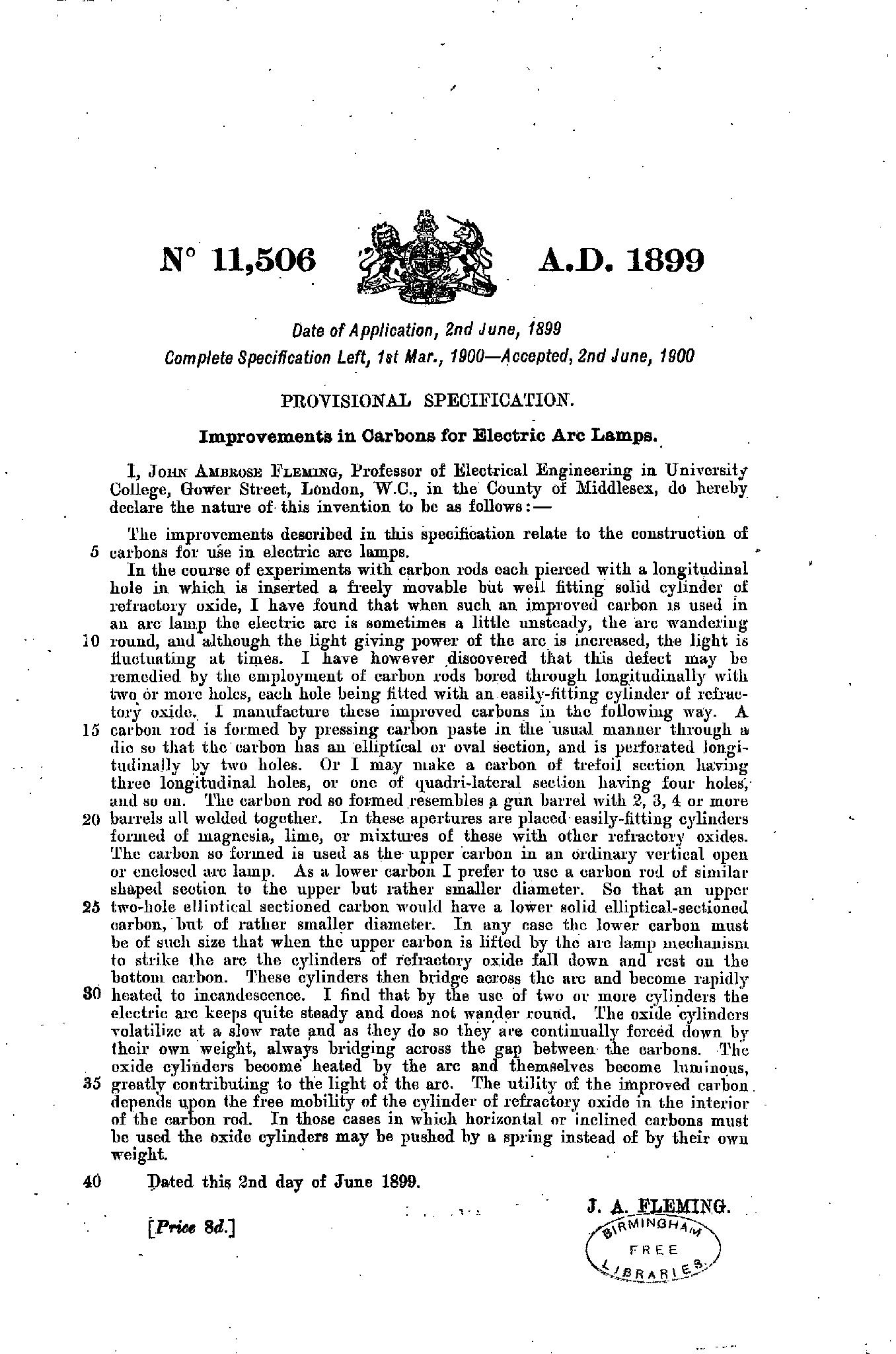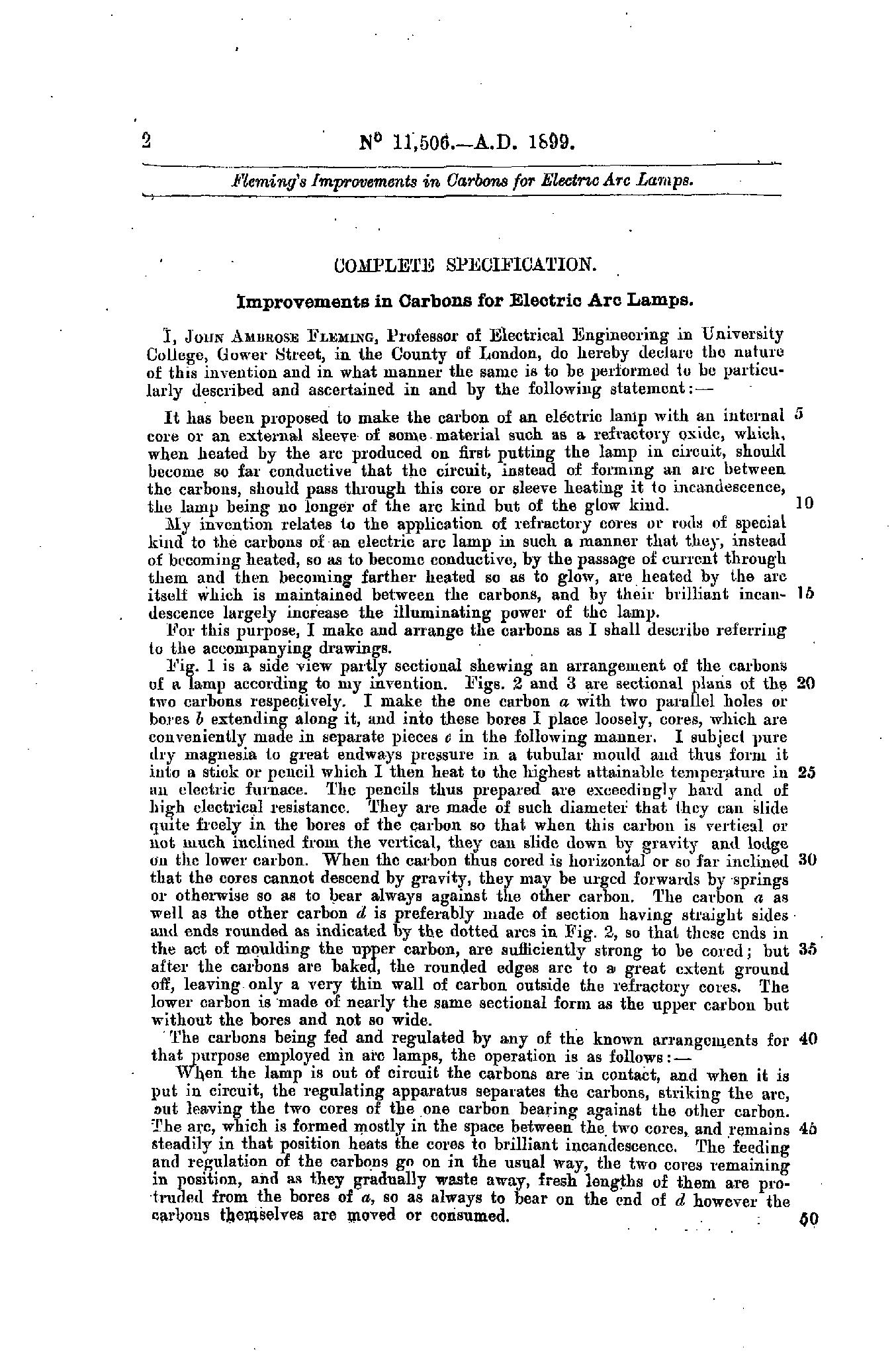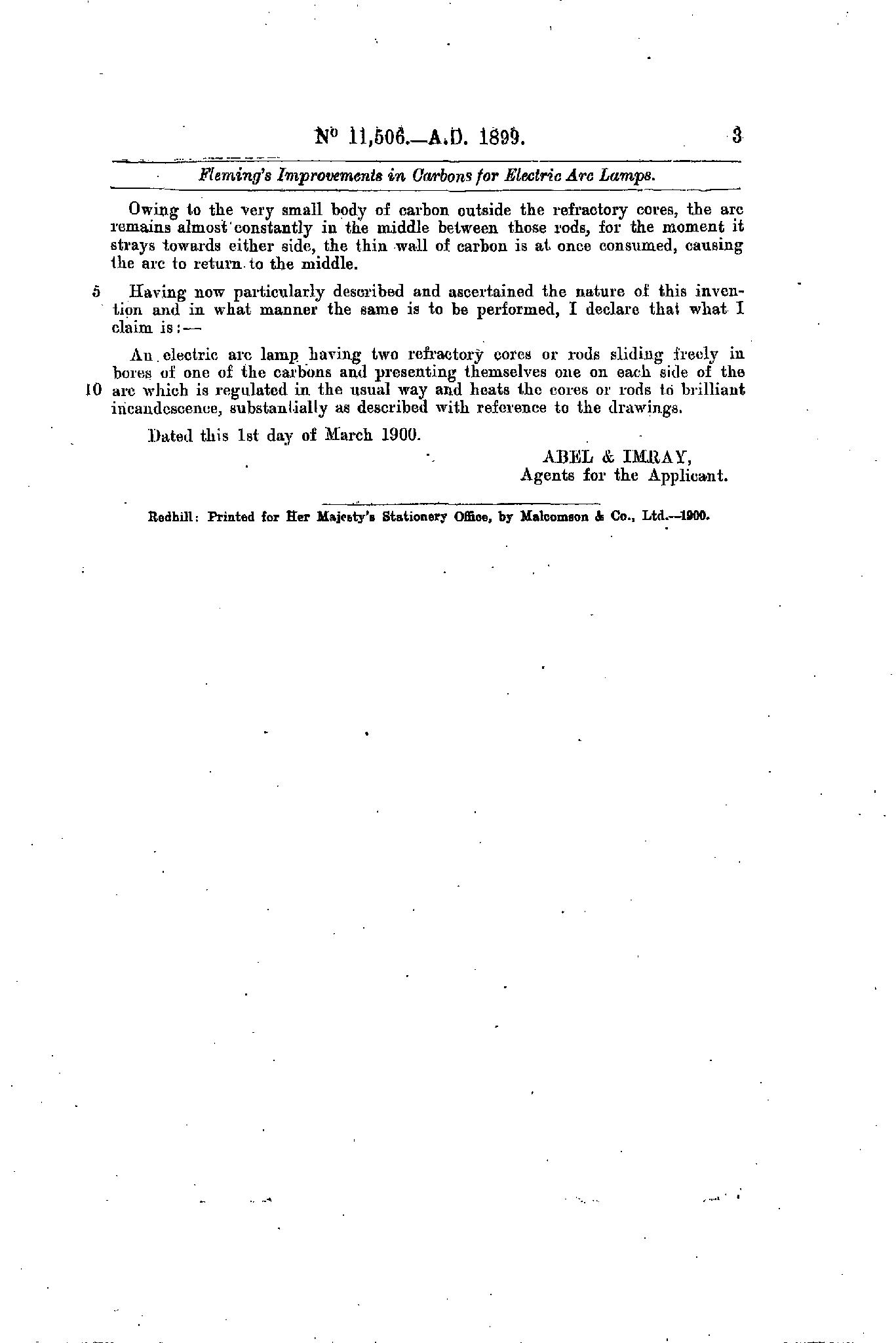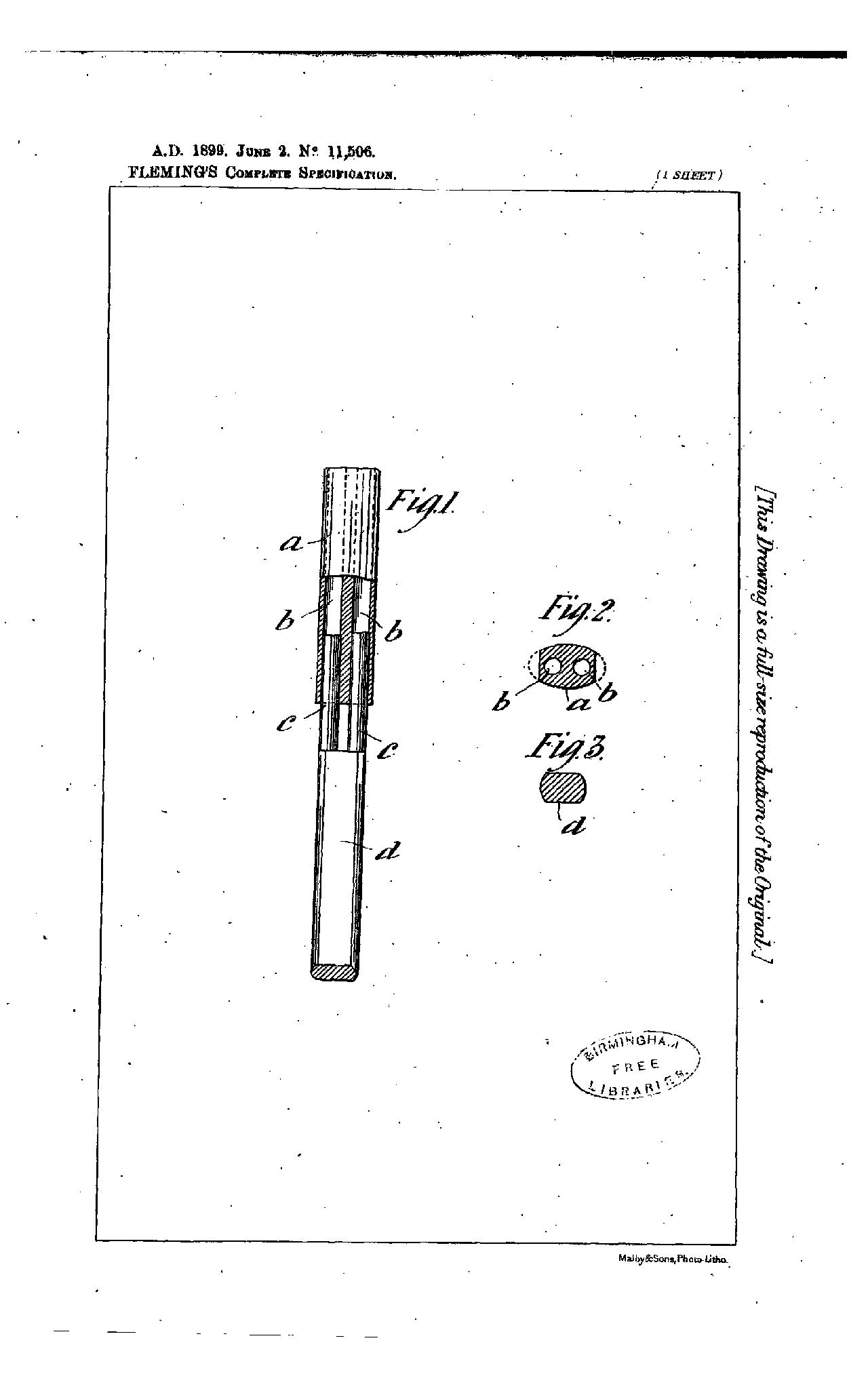 |
 |
| Doc Fleming |
| History telegraph |
| History telephone |
| History radio |
| History TV |
| History comp. |
| Scientists index |
| Bibliography |
|
Sir
John Ambrose Fleming
| ||
|
Documents:
| ||
| Patent GB189911506 2 June 1899 | ||
| Improvements in Carbons for Electric Arc Lamps | ||
Abstract of
GB
189911506
(A)
11,506. Fleming, J. A. June 2. Incandescent - arc lamps. - An ordinary arc lamp is provided with carbons a, d, oblong in section, one of them a having two holes in it to receive loose refractory rods c, which are caused to bear against the solid carbon d, by gravity or springs. The refractory rods may be made by submitting pure dry magnesia to great pressure in tubular moulds, and afterwards highly heating in an electric furnace. The hollow carbons may be moulded of oval section, and afterwards ground down to reduce the amount of carbon at the sides as indicated in Fig. 2. In operation, the exposed parts of the refractory rods are maintained incandescent by the arc, which remains steadily between them. The Provisional Specification mentions the use of more than two refractory rods in one carbon. | ||
PROVISIONAL SPECIFICATION.
Improvements in Carbons for Electric Arc Lamps. | ||
I, Joiix AMBROSE FLEMING, Professor of Electrical Engineering in
University College, Gower Street, London, W. C., in the County of
Middlesex, do hereby declare the nature of this invention to be as
follows :- The improvements described in this specification relate to the construction of carbons for use in electric arc lamps. In the course of experiments with carbon rods each pierced with a longitudinal hole in which is inserted a freely movable but well fitting solid cylinder of refractory oxide, I have found that when such an improved carbon is used in an arc lamp the electric arc is sometimes a little unsteady, the arc wandering round, and although the light giving power of the arc is increased, the light is fluctuating at times. I have however discovered that this defect may be remedied by the employment of carbon rods bored through longitudinally with two or more holes, each hole being fitted with an easily-fitting cylinder of rcirac- tory oxide. 1 manufacture tlicae improved carbons in the following way. A carbon rod is formed by pressing carbon paste in the usual manner through a die so that the carbon has an elliptical or oval section, and is perforated long i- tudinally by two holes. Or I may make a carbon of trefoil section having three longitudinal holes, or one of quadri-lateral section having four holes', and so on. The carbon rod so formed resembles gun barrel with 2, 3, 4 or more barrels all welded together. In these apertures are placed easily-fitting cylinders formed of magnesia, lime, or mixtures of these with other refractory oxides. The carbon so formed is used as the upper carbon in an ordinary vertical open or enclosed arc lamp. As a lower carbon I prefer to use a carbon rod of similar shaped section to the upper but rather smaller diameter. So that an upper two-hole ellintical sectioned carbon would have a lower solid elliptical-sectioned carbon, but of rather smaller diameter. In any case the lower carbon must be of such size that when the upper carbon is lifted by the arc lamp mechanism to strike the arc the cylinders of refractory oxide fall down and rest on the bottom carbon. These cylinders then bridge across the arc and become rapidly heated to incandescence. I find that by the use of two or more cylinders the electric arc keeps quite steady and does not wander round. The oxide cylinders -volatilize at a slow rate and as they do so they are continually forced down bv their own weight, always bridging across the gap between the carbons. The oxide cylinders become heated by the arc and themselves become luminous, greatly contributing to the light of the arc. The utility of the improved carbon depends upon the free mobility of the cylinder of refractory oxide in the interior of the carbon rod. In those cases in which horizontal or inclined carbons must be used the oxide cylinders may be pushed by a spring instead of by their own weight. | ||
I, JOHN AMBROSE FLEMING, Professor of Electrical Engineering in
University CoLlege, Gower Street, in the County of London, do hereby
declare the nature of this invention and in what manner the same is to
be performed to be particularly described and ascertained in and by the
following statement:- It has been proposed to make the carbon of an electric lamp with an internal core or an external sleeve of some material such as a refractory oxide, which, when heated by the arc produced on first putting the lamp in circuit, should become so far conductive that the circuit, instead of forming an arc between the carbons, should pass through this core or sleeve heating it to incandescence, the lamp being no longer of the arc kind but of the glow kind. My invention relates to the application of refractory cores or rods of special kind to the carbons of an electric arc lamp in such a manner that they, instead of becoming heated, so as to become conductive, by the passage of current through them and then becoming farther heated so as to glow, are heated by the are itself which is maintained between the carbons, and by their brilliant incandescence largely increase the illuminating power of the lamp. For this purpose, I make and arrange the carbons as I shall describe referring to the accompanying drawings. Fig. 1 is a side view partly sectional shewing an arrangement of the carbons of a lamp according to my invention. Figs. 2 and 3 are sectional plans of the two carbons respectively. ' I make the one carbon a with two parallel holes or bores b extending along it, and into these bores I place loosely, cores, which are conveniently made in separate pieces c in the following manner. I subject pure dry magnesia to great endways pressure in a tubular mould and thus form it into a stick or pencil which I then heat to the highest attainable temperature in an electric furnace. The pencils thus prepared are exceedingly hard and of high electrical resistance. They are made of such diameter that they can slide quite freely in the bores of the carbon so that when this carbon is vertical or not much inclined from the vertical, they can slide down by gravity and lodge on the lower carbon. When the carbon thus cored is horizontal or so far inclined that the cores cannot descend by gravity, they may be urged forwards by springs or otherwise so as to bear always against the other carbon. The carbon a as well as the other carbon d is preferably made of section having straight sides and ends rounded as indicated by the dotted arcs in Fig. 2, so that these ends in the act of moulding the upper carbon, are sufficiently strong to be cored; but after the carbons are baked, the rounded edges arc to a great extent ground off, leaving only a very thin wall of carbon outside the refractory cores. The lower carbon is made of nearly the same sectional form as the upper carbon but without the bores and not so wide. .The carbons being fed and regulated by any of the known arrangements for that purpose employed in arc lamps, the operation is as follows:- When the lamp is out of circuit the carbons are in contact, and when it is put in circuit, the regulating apparatus separates the carbons, striking the are, out leaving the two cores of the one carbon bearing against the other carbon. The arc, which is formed mostly in the space between the two cores, and remains steadily in that position heats the cores to brilliant incandescence. The feeding and regulation of the carbons go on in the usual way, the two cores remaining in position, and as they gradually waste away, fresh lengths of them are protrurled from the bores of a, so as always to bear on the end of d however the carbons themselves are moved or consumed. | ||
Owing to the very small body of carbon outside the refractory cores,
the arc remains almost' constantly in the middle between those rods,
for the moment it strays towards either side, the thin wall of carbon
is at, once consumed, causing the arc to return to the middle. | ||
Claims of
GB
189911506
(A)
Having now particularly described and ascertained the nature of this invention and in what manner the same is to be performed, I declare that what I claim is :- An electric arc lamp having two refractory cores or rods sliding freely in bores of one of the carbons and presenting themselves one on each side of the arc which is regulated in the usual way and heats the cores or rods to brilliant incandescence, substantially as described with reference to the drawings. | ||
 | ||
 | ||
 | ||
 | ||